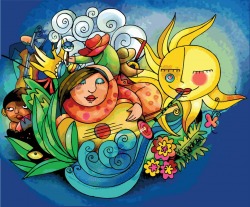
Why Strong Arts Programs in Schools Are Essential for All Students
Compiled by Kevan Nitzberg, Past President of Art Educators of MN.
The arts engage all students in education, from those who are already considered successful and are in need of greater challenges, to those who would otherwise remain disconnected and be at risk of not being able to realize their own potential for success.
Through exercising their imaginations, the arts help students to make new connections, transcend previous limitations and think ‘outside of the box’.
Expression in the arts helps students to develop cognitive and physical skills.
The arts provide an avenue for students to be able to express themselves and connect with their peers through personal growth and cooperative learning experiences.
The arts are a strong motivator for students to develop self-discipline and social skills.
The arts encourage self-directed learning, helping to develop the capacity of students to strive for greater success.
Each art form brings special ways of perceiving the world and mentally organizing and retrieving information, utilizing critical thinking and problem solving skills.
The arts help to transform the school environment to one of discovery and learning, breaking down barriers between disciplines and improving the conditions of learning.
The arts give students the opportunity to represent what they have learned, thus achieving greater comprehension and retention of the material being covered.
Art criticism helps students develop observation, analysis, interpretation and evaluation skills that can be transferred to other areas of study.
The arts are essential to an understanding of personal, local, national and global cultures, past and present.
Strong, sequential arts education programs in schools promote cultural literacy in our society.
The arts help to provide experiences for students to continue to become lifelong learners after they reach adulthood, creating awareness that learning is a never-ending process.
Education in the arts helps students to acquire those skills that will be essential to their being successful in the new millennium.
Information compiled by Kevan Nitzberg, Art Educator of MN, Past President of AEM
Reprinted with permission. Copyright 2007
Compiled by Kevan Nitzberg, Past President of Art Educators of MN.
The arts engage all students in education, from those who are already considered successful and are in need of greater challenges, to those who would otherwise remain disconnected and be at risk of not being able to realize their own potential for success.
Through exercising their imaginations, the arts help students to make new connections, transcend previous limitations and think ‘outside of the box’.
Expression in the arts helps students to develop cognitive and physical skills.
The arts provide an avenue for students to be able to express themselves and connect with their peers through personal growth and cooperative learning experiences.
The arts are a strong motivator for students to develop self-discipline and social skills.
The arts encourage self-directed learning, helping to develop the capacity of students to strive for greater success.
Each art form brings special ways of perceiving the world and mentally organizing and retrieving information, utilizing critical thinking and problem solving skills.
The arts help to transform the school environment to one of discovery and learning, breaking down barriers between disciplines and improving the conditions of learning.
The arts give students the opportunity to represent what they have learned, thus achieving greater comprehension and retention of the material being covered.
Art criticism helps students develop observation, analysis, interpretation and evaluation skills that can be transferred to other areas of study.
The arts are essential to an understanding of personal, local, national and global cultures, past and present.
Strong, sequential arts education programs in schools promote cultural literacy in our society.
The arts help to provide experiences for students to continue to become lifelong learners after they reach adulthood, creating awareness that learning is a never-ending process.
Education in the arts helps students to acquire those skills that will be essential to their being successful in the new millennium.
Information compiled by Kevan Nitzberg, Art Educator of MN, Past President of AEM
Reprinted with permission. Copyright 2007
 RSS Feed
RSS Feed
